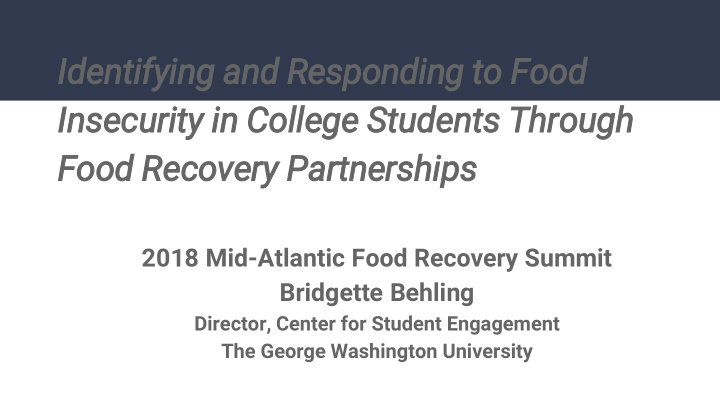



Id Identifying and Responding to Food In Insecurity in in College Students Through Food Recovery Partnerships 2018 Mid-Atlantic Food Recovery Summit Bridgette Behling Director, Center for Student Engagement The George Washington University
Defining Food Insecurity “Limited or uncertain availability of nutritionally adequate and safe foods, or ● the ability to acquire such foods in a socially acceptable manner” – USDA ● “Over 30% of college students surveyed stated that they have gone hungry due to a lack of funds during a college semester “ - WI Hope Lab Food Insecurity Study 2016 ● College University Food Bank Alliance: Grown from 4 in 2008 to more than 641 college food pantries at colleges/universities nationwide as of July 2018 ● “48% of college students reported food insecurity in the last 30 days” -College University Food Bank Alliance (CUFBA) Hunger On Campus Report, 2016
GW has very generous financial ○ The George aid packages that come close Washington to covering full need of its University & students Financial Aid On average, cover 89% of ○ demonstrated need While packages are improving, ○ and we are monitoring this closely, the gap that exists can indeed be a challenge for some students
What We Found at GW… GW student survey conducted ● What We Found 59% of undergraduates surveyed ate less than they felt they should at least ● once a month because there was not enough money for food 30% of graduate students ate less than they felt they should at least once a ● month because there was not enough money for food
The Store’s Guiding Values Education is a right not a privilege, and it has the power to overcome any and all obstacles Trust and believe in the students who have requested access Have faith in these students to take what they need Students using The Store must be respected and empowered so that they can take control back in this aspect of their lives Respect the anonymity and privacy of all Shoppers Store is providing a bridge for students but is not a permanent solution to the issue of affordability This effort cannot impact current donation programs from GW to the community and we must not negatively impact existing community resources and programs
The Store: Quick Facts Student engagement model Co- operated by staff from GW and students who’ve formed a student organization 2016-2017 estimated that 250 students would use it – closed year with over 600 Shoppers 2017-2018 academic year closed with over 800 Shoppers using the Store Open every day 6am-2am Students are only required to disclose identities one time; given tap access with their student ID card Currently distributing over 26,000 pounds of food /year
The Store Shopper Demographics 2017-18
The Store Shopper Demographics 2017-18
Grocery Stores and Manufacturers Food Banks vs. Food Pantries Food Banks Food Pantries
● Some students may not meet Why Campus- some community-based food Based Food bank requirements Pantries? ● Student discomfort in seeking services off campus ● Location – limited transportation resources
Capitol Area Food Bank ○ Partnerships in Panera ○ Food Recovery Bread for Life ○ Hungry Harvest ○ Target ○ Food Recovery Network ○ Amazon/Whole Foods ○ Various one-time partnerships ○ Sodexo ■ University events ■ GW’s Grow Garden** ○
Questions?
Contact me: Bridgette Behling Director, Center for Student Engagement The George Washington University bbehling@gwu.edu 202-994-5491
Recommend
More recommend